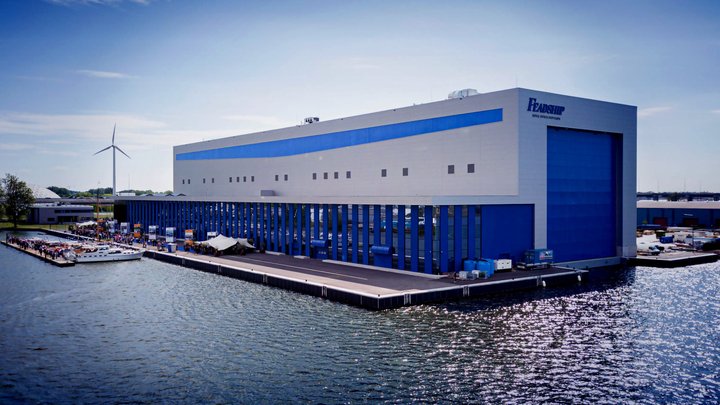
The Build
A Feadship from start to finish
The first of many memorable journeys owners enjoy on their Feadship is the actual building process itself. At a recent launch ceremony one owner said: “Creating something like this is as much fun as sailing the boat.” Find out why...


After the initial contact, a one-to-one meeting with a Feadship Director is set up. This is sometimes also combined with a visit to the yard. Clients get a glimpse behind the scenes, and the potential owner and builder have the chance to get to know each other properly.


Our naval architects, designers and technical team will then present preliminary concepts in the form of sketches and models. Together with the owner and their feedback, details such as layout, general styling, power, size, special features and delivery date are refined. This phase takes, on average, between four and five months. However, due to the importance of the process, there are no time restrictions.


Ideas, wishes and needs
The next few meetings are creative brainstorms, during which the ideas, inspirations, wishes and needs of the client are shared. Other important people, such as the captain, the owner’s spouse, their business partner and external architects, often join these meetings, when necessary.
Designs and refinements to the specifications are carried out based on previous meetings. When the client and the design team are completely satisfied, the final agreement for the project is ready to be signed. A glass of champagne is shared, the drawings go up on the walls, and the creation of the new Feadship truly starts.

Each unique hull shape is designed, calculated and optimised for speed, efficiency and comfort. Large-scale models of the designs may be created to assess the new design in a tank test.


Interior mock up
Part of a room is recreated at the yard in the proposed interior style. It is a great way for the owner to experience, and finally confirm, their choice of interior details, materials, fabrics and fittings. It is also the moment to choose tenders and water sports equipment such as jet skis and diving apparatus.


Final Design
When all of the final elements are approved, and when everyone is entirely happy, the final designs are agreed and signed off.


Detailed construction plans are made so that the physical build can begin. These will include exact choices of aluminium and steel in accordance with the final design, along with piping designs and airflow schematics. The metal used for the hull weighs, on average up to 6,000kg per m3.


Each owner has the honour of welding the very first section of hull, placing a coin or memento (such as a family picture or that day’s newspaper) inside for good luck.
The hull and superstructure are built in several sections. Whilst this takes place, the owner is busy choosing the latest onboard entertainments systems, and agreeing the final touches to the yacht’s interior and exterior.


Now, the huge sections of hull and superstructure come together, and a new Feadship starts to take shape in the dry dock. All mounting, pipes and ducting are laid into the hull, and the first of more than 115km of perfectly straight cabling are laid by hand.


Hardware installed
The larger elements, /such as the engines, generators, shore convertors and stabilisers, are all carefully placed into the hull.


Fairing and painting
Up to 10 layers of fairing are applied, with accuracy down to tenths of a millimetre, to ensure the perfect base. Only then is the surface ready for painting.


The interior installation starts in the crew areas, and moves upwards to the owner’s deck. The bridge equipment is installed, and the exterior installation starts. When the last of the deck is laid, it marks the completion of all welding and painting onboard.
Highest point
Upon reaching the highest point of the mast, the workers toast the new Feadship. This is a great time for the owner to visit. Many owners present the workers with a small token of their appreciation; often a keepsake featuring the yacht’s hull number and profile.


The champagne moment arrives. It is an incredible day for everyone involved; the culmination of three years work. All the workers and their families attend, speeches are given, and superstition dictates that a lady performs the naming ceremony.
The newly christened vessel launches for the very first time. All systems are tested in dock trials, and then the new Feadship is towed by tugboat from the yard to Rotterdam, along the canals.


Propellers, rudders and stabilise
The yacht is briefly brought into the dry dock at Rotterdam for the fitting of all of the large outboard elements.


Sea trials
The new Feadship is returned to the water and takes to the North Sea for testing. Manoeuvrability, braking, anchoring, speed, interior sound and interior vibration are all measured. Everything is carefully assessed, and must be absolutely perfect.
Upon successful trials, she then sails to Amsterdam Harbour for the very final interior fitting. All interior elements and loose additions, from pieces of artwork and furniture to gymnasium equipment and cutlery, are delivered. The crew and captain then undergo thorough onboard training


Finally, the new Feadship is ready. The fruit of an incredible partnership between the owner and builder – as individual as a fingerprint. The new crew and captain prepare to set sail for the first official journey.

Time for a well deserved holiday on board with family and friends and make plans to explore the world in comfort, safety and style.
